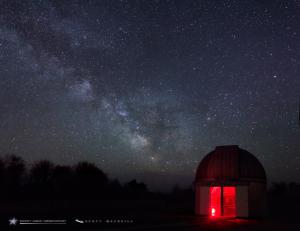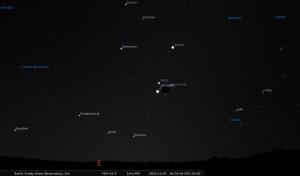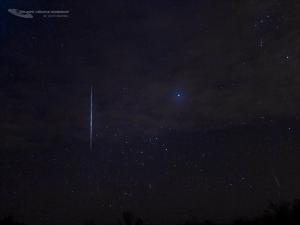
Stargazing Night
- Where:
- Frosty Drew Observatory
- When:
- Friday November 6, 2015 at 7:00 p.m.
- Cost:
- $1 Suggested Donation per Person
Tonight is Stargazing Night at Frosty Drew Observatory and, unfortunately, tonight's forecast is not looking all that spectacular. With mostly cloudy skies, moderate winds, fog, and a chance of rain in store for us, it is unlikely that telescopes will have a view of the cosmos. This is quite regrettable as the 15% waning crescent Moon does not rise until 2:30 a.m. and would have offered up fabulous dark skies to celebrate. Add in that the best conjunction of all previous conjunctions these past few weeks is happening in the early morning sky and this forecast is flat out harrowing. Though I'll keep a glimmer of hope that we may see periodic clearings and catch site of the conjunction.
We will open the Observatory and Sky Theatre at 7:00 p.m. tonight. In the Observatory, telescopes will remain closed and tours will be available. The Sky Theatre will have presentations on some of the celestial objects we frequently observe at Frosty Drew Observatory with an open discussion on general astronomy. We will officially stay on standby in case a clearing happens. If so, we will open a telescope to check out the sky. We'll likely stay on site quite late with the anticipation of catching the conjunction and will post on our Twitter (@FrostyDrewOBSY) and Facebook when we decide to pack it in.
Overall, tonight's forecast is dreaded and stargazing opportunities are remote. There is a small chance for periodic clearings overnight, though unlikely. These are the nights that offer you a chance to connect with our astronomers and get some answers to those cosmic questions. So stop in and kick back with our astro-geeks and catch up on all the awesome things happening in astronomy and astrophysical science!
-------------------------------------------------------------------------
Weekly Happenings
Scott MacNeill
This past month we have had numerous conjunctions in the early morning sky involving Venus, Mars, Jupiter and the waning crescent Moon. Well tomorrow morning, starting about 3:30 a.m. and continuing until sunrise, an absolutely stunning conjunction will happen as the crescent Moon, again, joins the dance of the morning planets. Venus, Mars, and the 15% crescent Moon will all appear within 2° of each other in the eastern sky, with Jupiter hanging 8° above. This will make for a fabulous conjunction that you certainly do not want to miss. New England may be under clouds, though the window of viewing opportunity will last for a couple hours, giving the sky a chance to offer periodic clearings of the stunning conjunction among passing clouds. Grab a toasty cup of Saturday morning comfy and head out for another celestial treat compliments of the Solar System!
This past week, the annual Taurid Meteor Shower has been happening. Although not the most promising shower of the year, the Taurid shower has certainly raised eyes to the sky this year. The shower is a result of Earth passing through a debris field left behind from Comet Encke, which orbits the Sun once every 3.3 years. In the debris field are narrow zones of higher density debris measuring a bit larger than average. If Earth passes through one of these zones, we see a significant increase in the number of super bright fireball meteors overhead. Fireball meteors last longer, are bright enough to illuminate the ground, and usually have visible fragmentation sometimes producing sound. It was predicted that Earth could pass into one of these zones this year and it appears that prediction was spot on. This past week, fireball meteors have been putting on a fabulous show for sky watchers worldwide. We saw two fireballs over a period of two hours at Ladd Observatory this past Tuesday and I saw three fireball meteors Wednesday night at Frosty Drew Observatory. The increase in fireball meteors will continue until November 10th with the best times to watch in the hours around midnight. So get out and catch a sighting. If you happen to see a fireball meteor bright enough to light up the ground, report it to the American Meteor Society and become a fireball spotter. Happy sky watching!
Ever want to work on the International Space Station (ISS)? How about joining the mission team on board NASA's Orion deep-space vehicle? Well this is your chance to make that dream come true as NASA has begun accepting applications for the next class of U.S. Astronauts! This class of astronauts will be the first to fly on new American made spacecraft that will launch from the Space Coast of Florida. Inspiring the Mars generation and advancing the boundaries of technology research in space will be some of the goals of the recruited class of astronauts. A bachelors degree in engineering, biological science, physical science, or mathematics is required. NASA will be accepting applications from December 14 – mid-February. Visit NASAs Astronaut page and learn about how awesome it is to be an astronaut, then visit USA Jobs after December 14th and submit your application for the most amazing job ever! Still a student but want to go to space (who wouldn't)? Well grab onto the Science Technology Engineering and Mathematics (STEM) buzz. These areas of study are the future of research and exploration with opportunities abound. So let out that inner geek and get yourself into the space program!
-Scott



